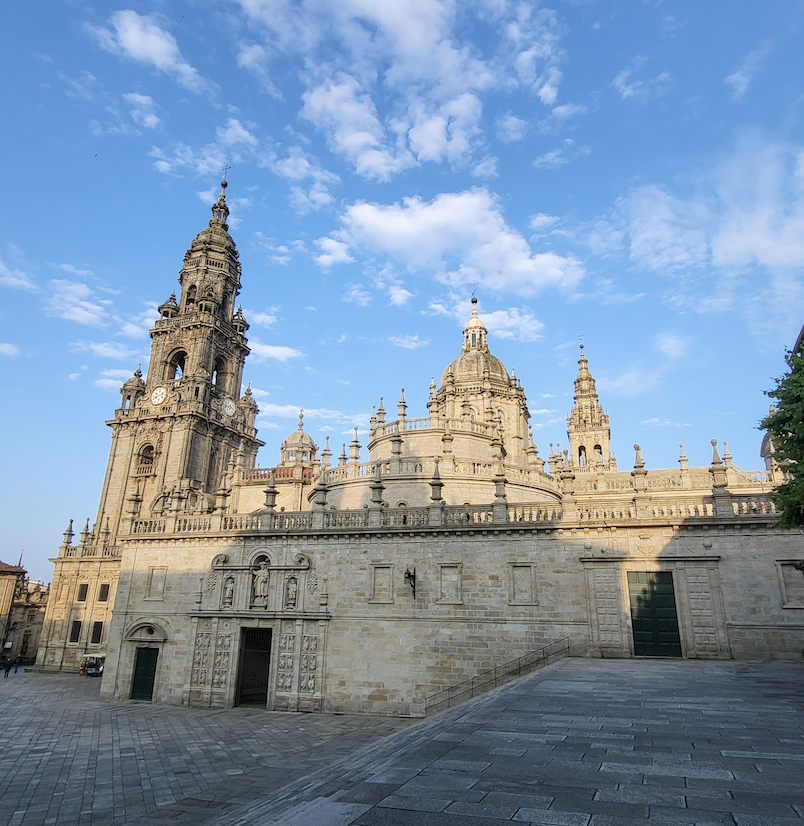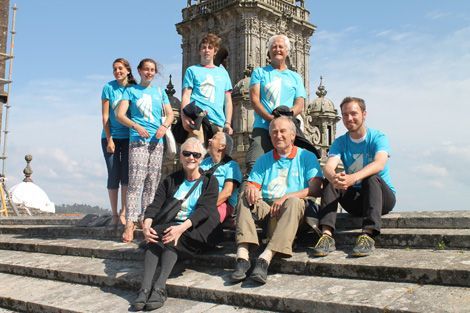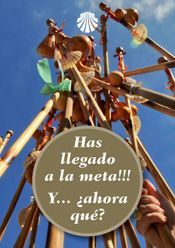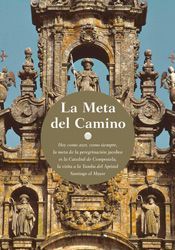Pilgrimage
Pilgrim’s Office
The Pilgrim’s Office receives and welcomes pilgrims arriving in Santiago who have walked, cycled or who have ridden on horseback to the Tomb of the Apostle Saint James the Elder. Here the “pilgrim credentials” are stamped with the end of The Way stamp, that of the Cathedral of Santiago, and here is where the traditional pilgrimage certificate known as the “Compostela” is issued.
Pilgrim’s Office: Rúa Carretas, 33 – CP 15705. Santiago de Compostela
Telephone: 0034 981 568 846
The Pilgrimage to Santiago de Compostela
PILGRIM’S PRAYER
Saint James, Apostle, chosen among the first. You were the first to drink the Cup of the Master and you are the great protector of pilgrims; make us strong in faith and happy in hope on our pilgrim journey following the path of Christian life and sustain us so that we may finally reach the glory of God the Father. Amen.
Pilgrimaging is a common rite in most religions. Santiago is one of the three important pilgrimage cities of Christianity, alongside Jerusalem and Rome. When European Christians saw that their faith was threatened by the advance of Islam, they asserted it by pilgrimaging to the recently discovered Sepulchre of the Apostle Saint James, in the 9th century. This is how, step by step, routes that led to Santiago were created, thus establishing a type of union between the different European countries and regions. The 12th and 13th centuries were the golden age of pilgrimages to Santiago. Later, during the Renaissance and Reformation, the Saint James phenomenon suffered attacks, but it managed to survive, albeit with a lower influx of pilgrims. The Bull by Pope León XIII “Deus Omnipotens”, which verified the authenticity of the apostle’s relics, represented a renewed impetus for the Saint James pilgrimage, which grew during the 20th century until the present, when pilgrimaging is strong and on the rise.
The pilgrimage to Santiago takes us to the Tomb of an Apostle, one of the twelve who were part of Christ’s intimate circle and who was responsible for the evangelization of Hispania, that is to say, he transmitted the original faith received from Jesus.

The Way
There are different pilgrimage routes to Santiago. Traditionally, pilgrims left their home to arrive at the “House of Saint James”, the Cathedral, and therefore it would be difficult to establish all the possible pilgrimage routes. The Way of Saint James is not an end in itself, but a means of arriving at the destination: the Tomb of Saint James. However, it can be said that there are several major and traditional routes that receive the greatest flow of pilgrims:
The French Way
The route that is most used today and which enters the Peninsula through Roncesvalles, passing through Pamplona, Logroño, Burgos, León, Astorga, Ponferrada, and entering Galicia through O Cebreiro.
The Northern Way
It borders the Cantabrian coast, passing through Irún, San Sebastián, Bilbao, Santander, Gijón, Avilés and entering Galicia through Ribadeo.
The Primitive Way
It begins in Oviedo and leads pilgrims to Santiago through the interior of Asturias, passing through Lugo and joining the Northern Way and the French Way in its final stage.
The English Way
Thus known due to the flow of pilgrims from the British Isles, who travelled by sea and landed in A Coruña or Ferrol and from there continued on foot.
The Portuguese Way
Passes through different routes in Portugal (interior and coast) until it enters Galicia through Tui.
The Portuguese Way of the Coast
From Porto, it runs along the Portuguese coast to Caminha and enters Galician territory at A Guarda, after crossing the mouth of the Miño.
The Vía de la Plata
Begins in Seville and passes through Mérida and Zamora, entering Galicia through Ourense.
The pilgrimage needs to be prepared from different angles: the physical, the spiritual and also by collecting information. This can be obtained from the Pilgrim’s Office, at the Bishoprics, in the Saint James Brotherhoods, and at the Friends of The Way Associations, where former pilgrims and people involved in pilgrimaging provide interesting information and practical advice.
Rites of the Pilgrims
EMBRACE THE APOSTLE
VENERATION OF THE SEPULCHRE OF THE APOSTLE SAINT JAMES
Go around the temple to the main facade, the Obradoiro. Observe its grandiosity: you are here, where you longed to be. Make the sign of the Cross. Don’t rush, this is the arrival point, the time to enjoy each step you take. I was glad when they said to me “Let us go to the house of the LORD“! Our feet have been standing within your gates, O Jerusalem.
You are welcomed by this magnificent Romanesque work representing the Story of Salvation. To the left, the desire of the coming of Christ, symbolised by four prophets from the Old Testament. To the right, the annunciation of Christ by the four Apostles; the New Testament. In the centre, Christ surrounded by his glory. He is the temple, the mediator between God and men, the priest. He is the door. Through Him we communicate with divine life, through Him we enter true life through faith. In the central column, the mullion, Saint James, the Apostle, sent by Christ to transmit that faith to us. Through faith, enter the door, which is Christ, and say: “I believe in one God…”
Our visit takes us to the Main Altar, which we circle in order to climb up and embrace the image of the Apostle which presides the temple. Thank you my friend Saint James, brother Saint James, for helping me to get here! Thank you for your company, for your testimony and your legacy!
Under the altar of this crypt lies the true destination of The Way: the walls of the ancient tomb and in the centre the urn containing the remains of the Apostle. And you are here, Saint James, in this part of the world. You arrived here to announce Christ and here you remain to encourage our search and our faith. Strengthen my faith, my Christian life, which so often seems to wane. You the strong, you the intrepid, you Son of Thunder.
You will see confessionals throughout the temple and confessors in different languages. Along The Way you have discovered your wounds, your disloyalties, your sins. Through the sacrament of confession you place your sin in the loving and healing hands of Christ, so that he can renew your existence. Have mercy on me, O God, in your faithful love; in your great tenderness wipe away my offences. Create in me a clean heart, O God, and put a new and right spirit within me.
Pilgrims from so many places, with so many languages, we sit around your table, Lord, around your Eucharist. To sit by you like Saint James did so many times, to be with you, to listen to you, to learn from you, so that you encourage and strengthen us with your own life, with your own Body.
Go to the south door, the Platerías door. Look at the facade. On the mullion, between the two door arches, there is a Chi Rho, symbol of Christ. But the letters are backwards: the Alpha has become Omega, and vice-versa. The end becomes beginning. The destination of The Way is now the beginning of another journey, of your new life.
Holy Year
It is Holy Year in Compostela when the 25th of July, Commemoration of the Martyrdom of Saint James, falls on a Sunday. It takes place every 11, 6, 5, 6 years. It originated in 1122, with Pope Callixtus II, and was later confirmed by Pope Alexander III through the Bull “Regis aeterni” from 1179, granting it perpetuity.
Throughout the centuries the See of Peter has on many occasions praised the pilgrimage to Santiago and the Holy Year.
“We call upon ourselves dear sons and daughters to follow that path of evangelic faith, of Christian authenticity and illuminated hope which, for centuries has guided so many souls to the Temple of Compostela”. (Paul VI: A. St 1971).
“I share the joy… for the period of favour and pardon that the Lord grants, once again, to the beloved community of Spain and all of Christianity… that the Jubilee is for everyone an occasion for true reconciliation”. (John Paul II: A St 1982).
“I express my special closeness to the pilgrims who have come and who will continue to come to Santiago. I ask them to treasure the evocative experiences of faith, charity and brotherhood that they meet with their journey, to experience the Way especially inwardly, letting themselves be challenged by the call that the Lord makes to each one of them. Thus they will be able to say joyfully and firmly at the Portico of Glory: ‘I believe’”. (Benedict XVI: A St 2010).
To earn the jubilee it is necessary to:
- Visit the Tomb of the Apostle in the Cathedral and say a prayer.
- Receive the sacrament of Confession (either in the cathedral or in any other place, fifteen days before or after).
- Receive the Communion. This Indulgence is applicable to the deceased.
Neither the Favour of the Jubilee nor the pilgrimage are linked, in themselves, to the Compostela. One can earn the Jubilee by travelling by any means and it is possible to obtaining the Compostela without earning the Jubilee.
Plenary indulgence, which can be gained once a day (applicable to the deceased), under the following conditions:
- Visit the Cathedral saying a prayer, e.g. the Our Father and Creed, praying for the intentions of the Roman Pontiff.
- Receive the sacrament of confession (15 days before or after) and the holy communion.
Faculties for confessors:
- All priests with licence to confess may hear confessions in the Cathedral, in the City’s parishes and at the Monte do Gozo.
- Absolution from “censures” except those reserved for the Holy See (v. CIC c 1367, 1370, 1378, 1382 and 1383) but with the faculties granted by cc 976 and 1357.
- Commute and dispense vows under the conditions established by the Church.
Christian Welcome
The Christian Welcome on The Way (Spanish acronym: ACC) is the effort by a significant number of Diocese and Church hostels (of parishes, religious orders, of brotherhoods…) to improve the service to the pilgrims on The Way of Saint James. It is true that the pilgrimage to Santiago has grown and changed quite a lot in recent years. The religious motivation is not the only one and for many pilgrims it is not the fundamental reason. However, it is for an important number of pilgrims, who seek better religious and spiritual attention. Ultimately, Christ—The Way, Truth and Life—is and will continue to go out to meet everyone who becomes a pilgrim, offering his Gospel for salvation. The Church has been involved since the beginning in the hospitality to pilgrims. Other agents that thirty years ago were not present on The Way, today play an important role in that hospitality, such as institutions, altruistic organisations, private companies, etc. Precisely now that the aspects of humanitarian attention are better organised thanks to this plural offer, there is the need to offer a more identified welcome. Everyone must be on The Way as what they are, and the Church is there to make Christ present and lead pilgrims to his encounter, because it firmly believes that only he can quench hunger and thirst with the truth, can really heal the wounds of the soul and provide relief for man’s tired heart. He is the destination and the meaning of human pilgrimage.
The ACC is not an instituted organisation, but a group of people who share illusions and work.Those of us involved are:
– The Pilgrim’s Office of Santiago de Compostela.
– The Interdiocesan Commission of delegates for The Way of Saint James.
– A series of masculine and feminine religious communities that execute the welcome along The Way: Benedictines, Augustinians, Cistercians, Franciscans, Dominicans, etc.
– Various priests and parish hostels.
– Hosts who devote their time and enthusiasm to serve pilgrims in church hostels and who try to accompany them along their faith’s journey.
If you consider that your hostel or parish should participate in this action, write to us at: info@acogidacristianaenelcamino.es
Further information at acogidacristianaenloscaminosdesantiago.org



